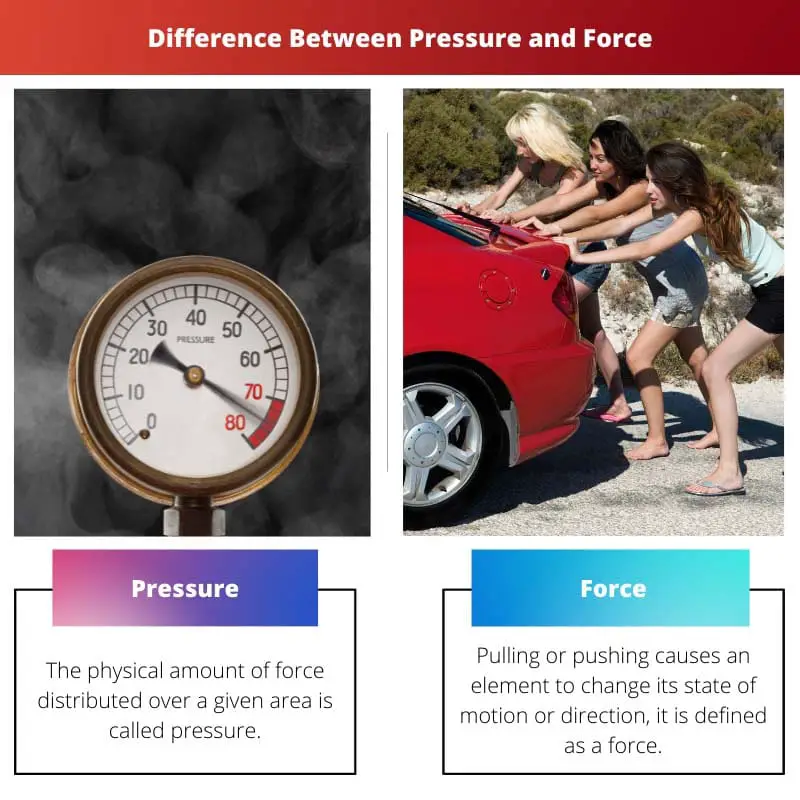In our daily life, we can easily find many phenomena connected to pressure.
For instance, when we sip drinks from a straw, we suck the air out of the straw. And when we sip the drink, we’re putting pressure on it. A force can cause a moving body to stop, accelerate, or change direction.
Key Takeaways
- Pressure measures the force applied over a specific area, whereas force measures the push or pull on an object.
- Pressure is a scalar quantity, while force is a vector quantity with both magnitude and direction.
- Units for pressure include Pascal (Pa) and pounds per square inch (psi), whereas units for force include Newton (N) and pound-force (lbf).
Pressure vs Force
Pressure is the force applied to a unit area of an object or substance and is measured in a standard unit called pascal. It does not affect the velocity of an object. Force is the physical energy that can cause a change in motion of an object. It is measured in newtons or pounds.

The physical amount of force distributed over a given area is called pressure.
In other words, pressure is force per unit area. The pressure exerted on a body is calculated by separating the sum of the forces exerted on the body by the connecting surface. It is measured in pascal.
Pulling or pushing causes an element to change its state of motion or direction, it is defined as a force.
When you hit a ball, for example, a force is exerted on it: the ball, which was previously at rest, enters a state of motion and remains in motion until stopped by friction and gravity.
Comparison Table
| Parameters of Comparison | Pressure | Force |
|---|---|---|
| Standard unit | Pascal, represented by the symbol Pₐ. | Newton, represented by the symbol N. |
| Meaning | The term “pressure” refers to a force that is applied over a large region. It is a response to something. It operates in a perpendicular direction to its surface. | Force is a type of push or pulls that occurs when two bodies interact and cause an item to accelerate. |
| Instrument | Manometer | Dynamometer |
| Velocity | It cannot be changed | Can be changed |
| Quantity | Scalar Quantity | Vector Quantity |
What is Pressure?
Pressure is defined as the force exerted per unit area of a surface. It is the force acting perpendicularly across the surface of the surface that causes it to propagate.
The pressure is small when force is applied to a large surface area and high when force is applied to a small area.
Pressure is the name given to the forces that propagate through the constant pressure of two objects against each other. The formula is as follows:
P = F / A
Or, Mathematically: Pressure = Force per unit area
pressure is denoted by P,
the extent of the outer force is denoted by F.
The area of the surface coming into contact is denoted by A.
Unlike force, pressure is a scalar quantity with only one size. The element of the pressure vector is the force vector that normally acts on the surface.
The force exerted by the weight of air in the atmosphere per unit area is known as atmospheric pressure. The pressure exerted by a gas in its equilibrium condition is known as vapor pressure.
Fluid pressure is produced by the mass and velocity of the atoms that make up the fluid. Movement can be defined as a change in speed or direction.

What is Force?
Force is the push or pull resulting from the physical contact of two things that changes or tends to change the object’s current state.
Force is a vector quantity, which means that both its quantity and direction are present. The force exerted on a part is determined by the magnitude of the force.
The state of motion is described by speed and meaning. The status of the movement is described by speed and direction. When you apply force to an element, it can alter its shape or state of movement.
When two separate forces are exerted on an object in the same direction, the resultant force is equal to the sum of the two forces. The resulting force is called the net force when more than one force is applied to a single element.
The resultant force is equal to the difference in the applied forces when two separate forces are applied in opposite directions. Pressure may not affect the velocity of a fluid, but force can change the velocity.
The forces are divided into several types, including, but not limited to:
- Contact Force
- Non-contact Force
- Gravitational Force
- Frictional Force
- Muscular Force
- Magnetic Force
- Electrostatic Force

Main Differences Between Pressure and Force
- Pascal is the unit of pressure, also known as Newton per square meter. Whereas In the metric system, Newton is the unit of force.
- Pascal is the unit of pressure, and it is defined as the force exerted on a specific area of an object on which it acts, while force is defined as the energy exerted on an object to change its direction of motion according to the law per square meter.
- The object’s velocity is unaffected by pressure. Whereas Force exerted in one direction can affect the velocity of an item.
- Pressure is affected by the magnitude. It’s a number with a scalar value. Whereas Force is a vector quantity, meaning it is affected by both an item’s magnitude and direction.
- Pressure does not have the ability to change the velocity. Whereas Force has the ability to change the velocity.





